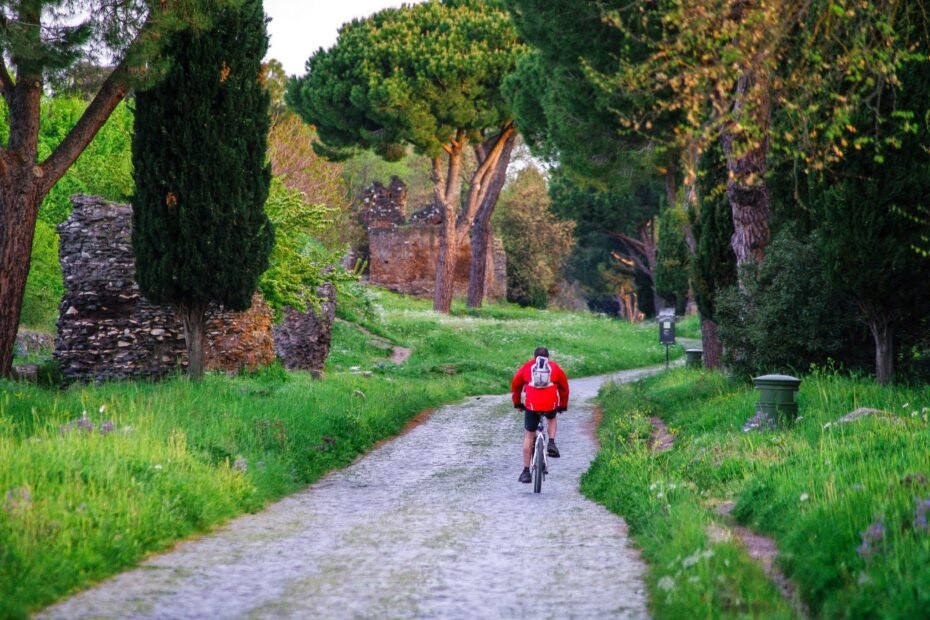The Via Appia (Appian Way) is one of the most famous ancient roads in the world, often called the “Queen of Roads” (Regina Viarum). It’s a must-see destination for history enthusiasts and those seeking a unique blend of Roman history, archaeological sites, and natural beauty. Here’s what you need to know as a tourist:
Historical Background
- Origins: Constructed in 312 BC by the Roman censor Appius Claudius Caecus, it was designed as a military road to connect Rome with Capua (later extended to Brindisi).
- Significance: The Via Appia was crucial for trade, military campaigns, and cultural exchange, remaining a vital route throughout the Roman Empire.
- Famous Events:
- Along this road, Spartacus’s followers were crucified after their rebellion in 71 BC.
- Early Christians often used the catacombs along the road for burial and worship.
What to See and Do
- The Road Itself
- Ancient Paving: Walk on the original basalt stones, still visible in many sections, and marvel at the engineering of Roman roads.
- Lined with Ruins: Discover ancient tombs, aqueducts, and milestones that tell the story of Roman life and death.
- Key Landmarks
- Porta San Sebastiano:
- Start your journey at this impressive gate, part of the Aurelian Walls, which served as the entrance to the Via Appia from Rome.
- Tomb of Cecilia Metella:
- A grand cylindrical mausoleum built in the 1st century BC for a noblewoman, one of the most iconic landmarks on the road.
- Catacombs of Rome:
- San Sebastiano: Contains early Christian art and relics.
- San Callisto (St. Callixtus): Known for its extensive burial chambers and early Christian frescoes.
- Villa dei Quintili:
- A luxurious villa of the Quintili brothers, later seized by Emperor Commodus.
- Circus of Maxentius:
- A well-preserved chariot racing stadium with adjoining imperial mausoleum.
- Porta San Sebastiano:
- Nature and Scenery
- The road runs through tranquil countryside dotted with pine trees, cypress groves, and fields, offering a peaceful retreat from the city’s hustle.
- Biking or Walking
- Rent a bike or take a leisurely walk along the road to fully immerse yourself in the atmosphere.
Practical Information
- How to Get There:
- Take a bus (such as #118 or #218) from central Rome to the starting point near Porta San Sebastiano.
- Metro Line A to Arco di Travertino, then transfer to a bus.
- Hours and Admission:
- The road itself is free to access.
- Individual sites like the catacombs or mausoleums may charge entry fees (typically €8–€10).
- Many sites are open from 9:00 AM to 5:00 PM, but check specific locations for details.
- Best Times to Visit:
- Early morning or late afternoon to avoid heat and crowds.
- Sundays are car-free, making it ideal for walking or cycling.
- What to Wear:
- Comfortable walking shoes are a must, as the ancient stones can be uneven.
- Bring a hat, sunscreen, and water, especially in warmer months.
Tips for Tourists
- Plan Your Route:
- The Via Appia spans miles, so decide beforehand whether to explore a short section or take on a longer adventure.
- Guided Tours:
- Consider a guided tour to learn about the road’s history and the significance of each site.
- Pack Essentials:
- Bring snacks, water, and a map or GPS to navigate the area.
- Combine with Nearby Attractions:
- Visit the Baths of Caracalla or the Aurelian Walls before starting your Via Appia journey.
Nearby Attractions
- Parco della Caffarella:
- A scenic park connected to the Via Appia, ideal for a peaceful picnic or additional exploration.
- Capo di Bove:
- A site showcasing the remains of Roman baths and a museum explaining the Via Appia’s history.
Fun Facts
- The Via Appia was one of the first Roman roads to be constructed using a layered technique for durability, including gravel, sand, and basalt.
- Early Christian pilgrims used the road to visit Rome’s sacred sites, making it a key part of religious history.
- Roman soldiers and merchants traveling along the road would have passed the same tombs and landmarks still visible today.
Cultural Significance
The Via Appia is more than just an ancient road; it’s a journey through time, connecting the present with the Roman Republic and Empire’s rich legacy. Walking or biking along its route is not only an exploration of history but also a chance to enjoy Rome’s natural beauty and architectural heritage.
Conclusion
The Via Appia offers a unique way to step back in time while enjoying the serene countryside just outside Rome. Whether you’re an avid historian, a photography enthusiast, or simply looking for an off-the-beaten-path experience, the Appian Way promises a memorable adventure.
